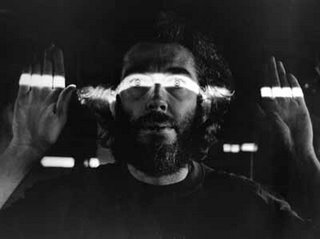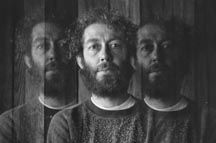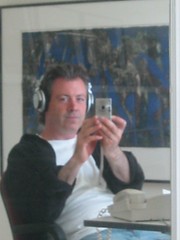Pentagram For Conjuring The Narrative

Hollis Frampton...a filmmaker/artist/writer who lived outside of Hamilton, NY...
A Conference on him and his work at Princeton University earlier this month...
Died in 1985.
Most memorable "thought piece": "A Pentagram For Conjuring The Narrative" from his book called "Circles of Confusion." Out of print, one copy available in an SF bookstore for $66 (should have saved that copy from class) and in French translation from the Pompidou in Paris -- it figures, per Clotaire Rapaille's recent comments on NPR, that the "sophisticated, nuanced, intellectual" French would have this in print...
An interesting (though dense) essay on "A Pentagram" by Matt Teichman at the Film Philosophy website.
 Great quote:
Great quote:"I was born during the Age of Machines.
A machine was a thing made up of distinguishable ‘parts,’ organized in imitation of some function of the human body. Machines were said to ‘work.’ How a machine ‘worked’ was readily apparent to an adept, from inspection of the shape of its ‘parts.’ The physical principles by which machines ‘worked’ were intuitively verifiable.
The cinema was the typical survival-form of the Age of Machines. Together with its subset of still photographs, it performed prizeworthy functions: it taught and reminded us (after what then seemed a bearable delay) how things looked, how things worked, how to do things...and of course (by example), how to feel and think.
We believed it would go on forever, but when I was a little boy, the Age of Machines ended. We should not be misled by the electric can opener: small machines proliferate now as though they were going out of style because they are doing precisely that.
Cinema is the Last Machine. It is probably the last art that will reach the mind through the senses.
It is customary to mark the end of the Age of Machines as the advent of video. The point in time is imprecise: I prefer radar, which replaced the mechanical reconnaissance aircraft with a static anonymous black box. Its introduction coincides quite closely with the making of Maya Deren’s Meshes of the Afternoon and Willard Maas’s Geography of the Body.
The notion that there was some exact constant at which the tables turned, and cinema passed into obsolescence and thereby into art, is an appealing fiction that implies a special task for the metahistorian of cinema.–Hollis Frampton, 1971
